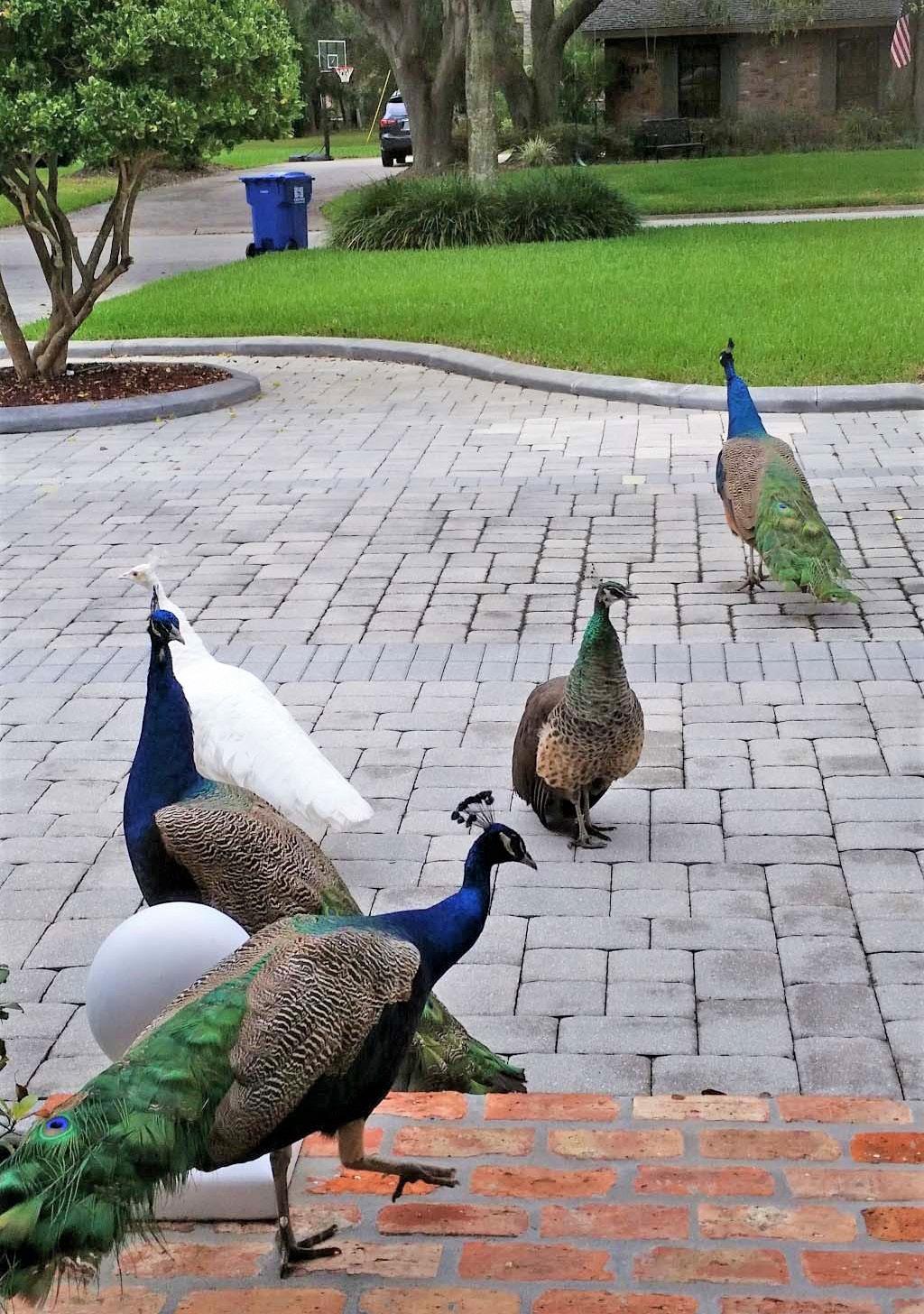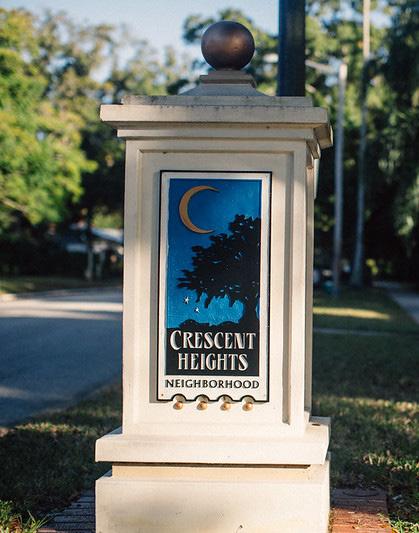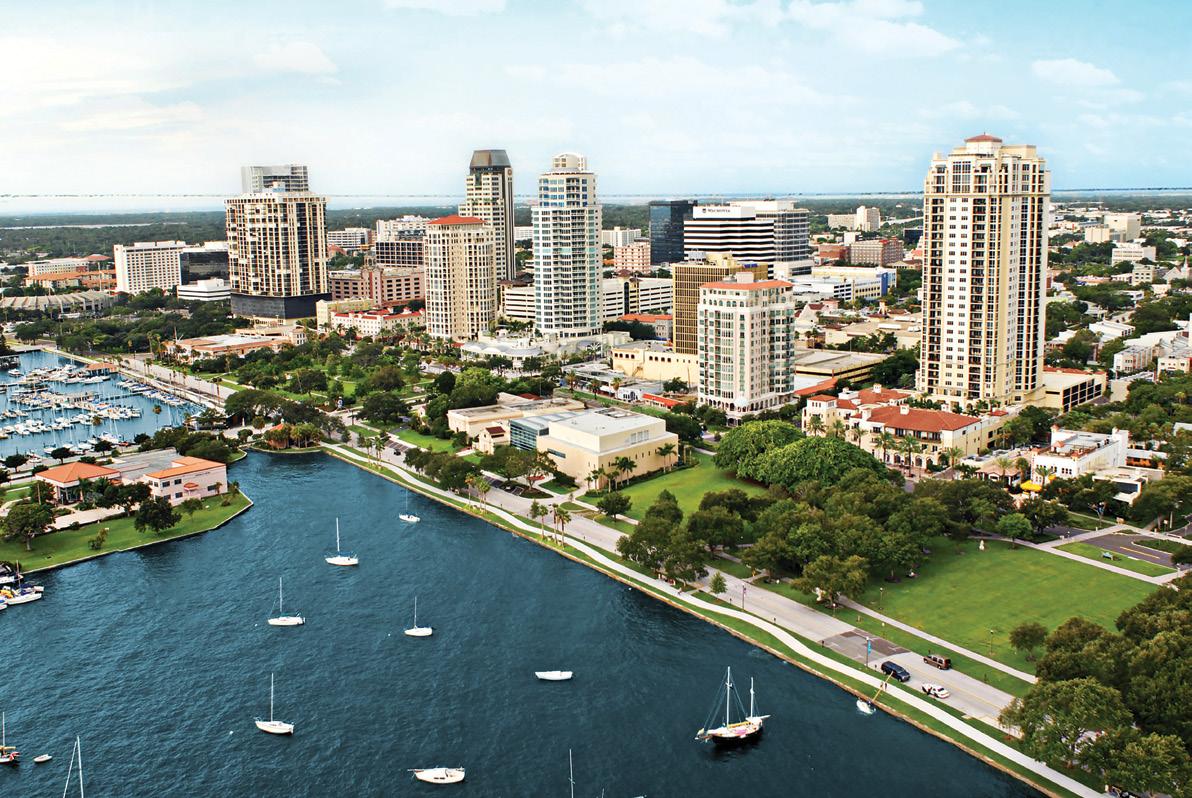
13 minute read
A Sense of Place
PHOTO/CITY OF ST.PETERSBURG
Looking for a new place to call home? Or maybe you have friends or family wishing to make the ‘Burg home. Here’s a look at the diverse array of residential neighborhoods outside of the downtown core that have a strong identity. All of these places share certain traits – their own unique character and a strong sense of community.
BY MARCIA BIGGS
Historic Old Northeast
Beautifully maintained 20th century homes built on a grid of narrow brick streets with granite curbing and hexblock sidewalks, all shaded by a mature tree canopy, are hallmarks of the Old Northeast. The highly desirable neighborhood located along the North Shore area in the shadow of the Renaissance Vinoy stretches from 30th Avenue N. to 5th Avenue N. bounded by 4th Street N. and Coff ee Pot Bayou. A designated landmark in the National Register of Historic Places, the neighborhood of single family homes, apartments and accessory dwellings is an easy walk to the waterfront and Beach Drive. Pride is taken in highly manicured yards and fl owering gardens. It has an active homeowners association, HONNA, which during normal times puts on annual events and gatherings throughout the year.
Nearby: North Shore Park and Recreation Center, the Palladium Theater, the Museum of the American Arts and Crafts Movement, Beach Drive, Vinoy Park, Straub Park
Historic Roser Park
Tucked away on the southern edge of downtown, between 4th Street S. and Dr. MLK/Ninth Streets between 7th and 11th Avenues S., Historic Roser Park is an eclectic collection of small bungalows and cottages, and stately historic Mediterranean and Spanish style mansions. Many residents work at the nearby medical centers and value the historic character and friendly camaraderie of the community.
Roser Park’s unique topography is characterized by steep to gently sloping hills, winding along Booker Creek, with lush vegetation and narrow brick streets. St. Petersburg’s fi rst historic district was developed by Charles Martin Roser in the 1910s, with hexagon block sidewalks, ornamental street lights and two small bridges crossing Booker Creek. A walking trail along the creek is lined with royal palms and 28 markers featuring the homes and their historical signifi cance.
Nearby: Bayfront Health St. Petersburg, Johns Hopkins All Children’s Hospital, Campbell Park Rec Center, Bayboro Harbor, University of South Florida St. Pete campus
Jungle Prada/Jungle Terrace
Head west from downtown to fi nd tropical Jungle Prada along Boca Ciega Bay, bordered by Admiral Farragut Academy near 9th Avenue N. to the south and 22nd Avenue N. to the north. While St. Petersburg is mostly a grid with numbered streets, the Jungle Prada area features winding brick streets and antique street signs with names like Elbow Lane, Jungle Avenue, Follow Thru Road, Par Avenue, Garden Avenue, Stimie Avenue, and Bogie Avenue. Some lot sizes are among the largest in the city.

An abundance of beautiful hardwood trees promotes the appeal of a tropical jungle and the area is just minutes away from sugar-sand beaches of Treasure Island and Madeira Beach. Families fl ock to this gracious community, which is home to Admiral Farragut Academy (former Jungle Prada Hotel), built in 1925.
The Jungle is known for its resident peacocks that can be seen wandering though yards and streets. The adjoining Jungle Terrace neighborhood to the north of 22nd Ave. N. centers around Walter Fuller Park, an oasis of green, and Tyrone Square Mall, an oasis for shopping.
Nearby: Admiral Farragut Academy, Boca Ciega Bay, Pinellas Trail, Tyrone Square Mall, St. Petersburg College Gibbs campus, Azalea Park and Recreation Center, Jungle Prada de Narvaez Park and Abercrombie Park
Greater Pinellas Point
Located at the southernmost tip of Pinellas County on Tampa Bay, this large neighborhood of more than 19,000 residents is renowned for its Pink Streets and Bird Cage homes. When the area was developed in the 1940s, pink concrete was poured to form wide, winding pink streets such as Serpentine Drive and 14th Street S. Bird Cage homes built by architect Glenn Johnson feature a large amount of screened area. Pinellas Point has lush landscaping and lots of vegetation.
Nearby: Sunshine Skyway Bridge, Ft. DeSoto Park, Eckerd College, Bay Vista Park, Lake Vista Park, Maximo Park
Old Southeast/Driftwood
The Old Southeast, just south of downtown and the USF campus, covers the area east of 4th Street S. south to 24th Ave. S and extends to the water’s edge of Tampa Bay. It is home to a large group of area artists, longtime residents and a growing number of young families taking advantage of some of the still aff ordable real estate.
Like many of the neighborhoods surrounding the downtown area, The Old Southeast has been experiencing growth and revitalization over the past few years but it also boasts some of the most historic and long loved features. For instance, Lassing Park, donated to the city in 1924 by Judge Robert B. Lassing, runs along Beach Drive SE with 14.2 acres of greenspace and a beach along the bay. It hosts many activities, like Fun Fitness Boot Camps, Ultimate Frisbee, yoga and kiteboarding events. Like Historic Kenwood, The Old Southeast has been offi cially designated an “Artist Enclave” by City Council.
Bordering on the south, the Driftwood neighborhood off Big Bayou is one of the area’s most historic gems with a small grouping of remarkable homes nestled in canopies of mature trees. The community was established and designed in the 1930’s by local artist Mark Dixon Dodd and architect Archie Parish. It’s a favorite walking route for all residents. Tropical Shores (population 315) is another wonderful neighborhood between OSE and Driftwood that jetties out into the bay and has some of the most spectacular water views in the area.
Nearby: The Dali Museum, Albert Whitted Airport, Old Southeast Market, Bartlett Park Tennis Complex, Salt Creek Marina, University of South Florida St. Pete campus. Old Southeast lays claim to one of downtown’s coolest historic and favorite burger joints – The Chattaway, established in 1922.
— Cindy Stovall
Historic Kenwood

Centrally located less than one mile west of downtown along the Central Avenue corridor between I-275 and 34th Street, Historic Kenwood has seen a renaissance in the last decade, attracting a diverse mix of artists, LGBTQ, and professional couples of all ages. Hexagon block sidewalks, canopies of oaks and fl owering trees line the numerous brick streets. Within walking distance are a wide variety of locally-owned and operated drinking and dining establishments in the Grand Central District.
Because of Historic Kenwood’s high concentration of artists of all types, the City Council sought to promote the arts and artists by declaring the neighborhood an “Artist Enclave.” This status enables artists of the neighborhood to teach classes and sell artwork from their homes. Kenwood’s claim to fame is one of the highest concentrations of Craftsmen-style bungalow homes in the state of Florida, some dating to the early 1900s. During normal times, the annual Kenwood Historic Home Tour, BungalowFest, is a community favorite.
Nearby: Tropicana Field, Suncoast Hospice Community Service Center, Jim and Heather Gills YMCA
Crescent Lake/Crescent Heights
Nature lovers flock to the neighborhoods surrounding Crescent Lake between 4th Street N. and Dr. MLK Jr Blvd., 22nd and 12th Avenues N. A 52-acre park with a 20-acre lake attracts residents who like the outdoors and the many species of birds and ducks that fl ock to the lake. A path that surrounds the lake attracts many walkers. The historic neighborhood with diverse architecture and many styles of homes is just minutes north of downtown and within walking distance of shopping and dining along 4th Street N. Look for the bright blue water tower and you’ve found it. To the north, Crescent Heights extends from 22nd to 30th Avenues N. with large and small homes, some dating back to the 1920’s.

Nearby: Sunken Gardens, 4th Street N. corridor, Trader Joe’s, downtown St. Petersburg
Broadwater and Lake Maggiore
The waterfront community of Broadwater in south St. Pete is a favorite for boaters and nature lovers who live on one of the canal homes that lead out into Boco Ciega Bay. From families to retirees, the neighborhood is a welcoming one of unpretentious homes on wide shady streets. Ocean breezes, pretty sunsets and the opportunity to see dolphins and manatee in your backyard bring many to Broadwater. Some homes are historic, while others are more modern.
Just east of the interstate, the residences bordering Lake Maggiore from 26th Avenue. S to 54 Avenue S. encompass Lake Maggiore Shores and Lakewood Estates. With the lake, Boyd Hill Nature Preserve, Lake Maggiore and Dell Holmes parks all nearby, families who love the outdoors fl ock to this welcoming area with its strong sense of community and middle-class homes. The St. Petersburg Country Club is here, too, a favorite for area golfers.
Nearby: Boyd Hill Nature Preserve, Pass-a-Grille Beach, St. Pete Beach, Fort DeSoto Park, Skyway Bridge, St. Petersburg County Club
Allendale/Allendale Terrace
Allendale residents pride themselves on their small close-knit community bordered to the south by 34th Avenue N., to the north by 42nd Avenue N., 7th Street N. to the east, and 12th Street N. and Haines Road to the west and southwest. The neighborhood is just minutes from I-275, the 4th Street N. corridor, and downtown St. Petersburg.
Known for its giant oak trees, brick streets and large estate homes, Allendale Terrace is considered by many to be the fi nest area of St. Petersburg that is not located on the water. It also includes the area between 34th Avenue N. and 38th Avenue N., from 9th Street (MLK) to Haines Road. Many homes are historic, built between 1922 and 1954. Cade Allen (hence the name Allendale) and his sons built a total of 40 houses in Allendale, many with a distinct appearance built with hollow clay tile and stone veneers that were later added. Some of the homes used local coquina rock.
Snell Isle

One of St. Petersburg’s most desirable waterfront communities, Snell Isle borders Coff ee Pot Bayou via the historic Snell Isle Bridge and is on the U.S. Register of National Historic Places. Snell Isle is completely residential, with several apartment communities, two schools, and two churches. Many original homes from the 1920s still exist today, with charming European and Spanish architecture. More than 80 percent of homes on Snell Isle enjoy waterfront views, some of the Bay and others on interconnected waterways. Residents here enjoy a boating lifestyle, while being only minutes away from the vibrant culture and restaurants of downtown St. Petersburg.
Nearby: Downtown St. Pete, Renaissance Vinoy Golf Club
2021 Forecast : Real Estate in St. Pete is in High Demand

The St. Petersburg housing market continues to boom with inventory being gobbled up nearly as soon as it’s listed. Real estate professionals are reporting more closed sales, more new pending sales, higher median prices and more new listings as we head into the new year. Condominiums are soaring more ways than up. “Many downtown condos are valued higher than the beach, which was not the case in the past,” Haydon said, mentioning one Ovation condo that sold for $6.5 million last year.
In December, St. Petersburg as a whole had about 40 percent less inventory compared to the previous year, said Cyndee Haydon, President of the Pinellas Realtor Association. Sales in the last quarter of 2020 were reaching 97%. Across Florida, single-family existing-home sales rose 26.9 percent compared to a year ago.
Super-low mortgage rates, some as low as 2.75%, are causing a buying frenzy. Haydon predicts the supply of available homes will tighten further in 2021 and prices will continue to rise with mortgage rates remaining low, at least in the fi rst quarter. “There is some speculation that these low rates may not last,” she said. “With a new administration in the White House, there may be some rebalancing later in the year.”
Real estate agents report that Florida, and the Tampa Bay area, are experiencing a surge in demand even as the coronavirus pandemic people are leaving the giant metro areas such as New York and Philadelphia in search of Florida sunshine and an outdoor lifestyle.
Haydon is seeing a lot of interest from young professionals. “St. Petersburg is especially attractive to the younger generation,” she said. The growing condo and apartment scene downtown is attracting fi nancially secure singles and couples who are looking for a dog-friendly city with diverse restaurants and bars, cultural and performing arts, and walkability.
Downtown’s condo and apartment inventory is projected to increase 65% over the next fi ve years, according to a study by St. Petersburg Downtown Partnership. There were approximately 5,250 condo and apartment units downtown in early 2020 at a combined 90+% occupancy rate. A number of residential projects are underway, as well as in planning stages. In downtown alone, some 17 multi-family residential developments were planned or in progress in 2020.
Condominiums are soaring more ways than up. “Many downtown condos are valued higher than the beach, which was not the case in the past,” Haydon said, mentioning one Ovation condo that sold for $6.5 million last year.
The Downtown Partnership study found that downtown grew by nearly 2,000 residents over the past fi ve years (13%) and with more than 3,500 units planned in the surrounding downtown, that growth will continue. Millennials (age 25-34) are the fastest growing age group, followed by Baby Boomers.
Families typically are seeking dwellings in the neighborhoods close to downtown. “I am seeing a lot of interest from Old Northeast along the 4th Street North corridor up to Shore Acres,” Haydon said. The median price for a single family home in St. Petersburg is $306,000, she added.
A major contributor to growth in St. Pete can be attributed to employment. A number of tech companies have moved to the shows no signs of easing. One factor that remains constant: More city in recent years, bringing an influx of new jobs and employee relocations.
Sperling’s Best Places Index indicates that St. Petersburg is extremely competitive with other similar size cities on the housing front. While St. Petersburg’s median home costs are nearly 13% higher than the U.S. median, it signifi cantly outperforms peer markets of Orlando, which is 22% higher and Miami, which is 74% higher. St. Petersburg prices are considered on par with peer markets Tampa and Charlotte. The Tampa Bay Metro area ranks No. 6 against all metros in the U.S. for authorizations of new, privately owned housing units.
Housing affordability is a hot topic now as high-priced condos and apartments price people out of the market. The city is using a variety of tools to increase the supply of market rate and affordable housing including a comprehensive 10-year strategy unveiled in July 2019. The plan establishes goals to increase the supply of aff ordable and market rate multi-family housing and establishes a goal of assisting more than 3,000 current homeowners to stay in their existing homes.
ON THE RISE
Saltaire, a 35-story condominium tower, has broken ground in the former parking lot of the Hilton St. Petersburg Bayfront Hotel at 300 1st Street South. Saltaire is expected to have 192 units priced between $850,000 and $5 million. Refl ection St. Pete, a proposed 18-story upscale condo tower planned near Mirror Lake, is expected to begin construction early this year. Units will range from the $500,000s up to $1.5 million.
Meanwhile, construction on 400 Central, a $300 million multi-use development project which includes a 46-story luxury condominium tower, is expected to begin in 2021. The Residences at 400 Central is proposing some 300 luxury units and will be the tallest building in St. Petersburg.



